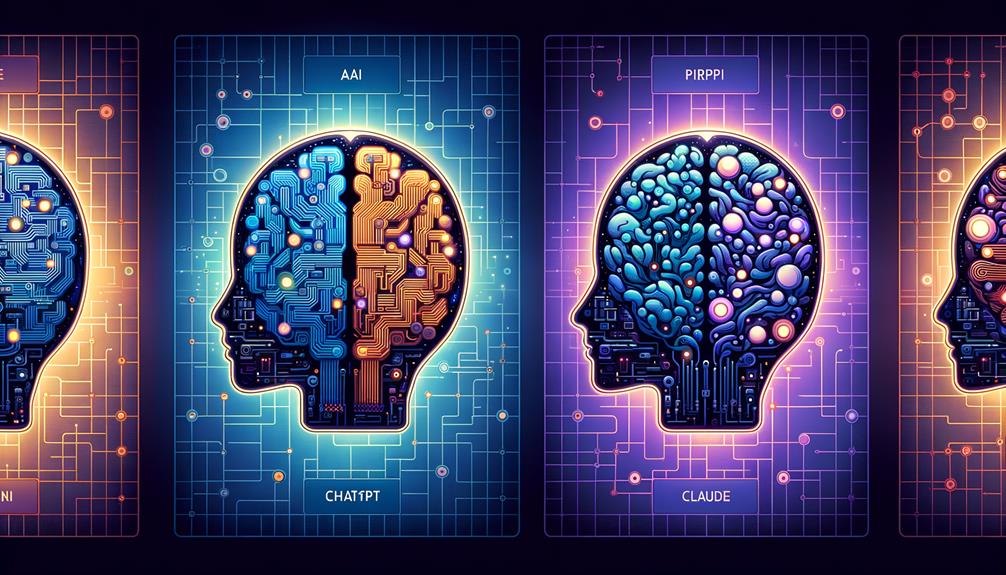

You're probably comparing ChatGPT, Claude, and Perplexity to determine the best AI model for your needs. Each excels in specific areas: Perplexity is ideal for research and data analysis, ChatGPT shines in drafting emails and creating social media content, while Claude dominates conversational applications. To choose the right tool, you need to understand their distinct strengths and capabilities. While all three models share some similarities, their primary use cases, interaction styles, and key features differ greatly. As you explore these differences, you'll discover which model reigns supreme for your specific requirements and unleash the full potential of AI.
When evaluating AI models, you'll find that each excels in distinct primary use cases, and understanding these strengths is key to choosing the right tool for your needs.
You're looking for an artificial intelligence[1] solution that fits your goals, and knowing where each model shines can make all the difference.
Perplexity AI is your go-to for research and data analysis, providing accurate, source-cited information perfect for academic and professional contexts.
ChatGPT, on the other hand, is a versatile tool for drafting emails, creating social media content, and engaging in customer[2] service.
Meanwhile, Claude dominates conversational applications and user engagement, earning its title as the 'content king'.
Comparing the interaction styles of AI models reveals distinct strengths, with each exceling in its own unique way of engaging users and delivering information. When you look at Perplexity AI, you find an emphasis on structured and information-centric interactions. On the other hand, ChatGPT shines with its conversational style, while Claude also focuses on conversational AI. You see a clear difference in how each model approaches dialogue.
| AI Model | Interaction Style |
|---|---|
| Perplexity AI | Structured and information-centric |
| ChatGPT | Conversational and human-like |
| Claude | Conversational with unique dialogue approach |
You notice that each model's interaction style is designed to excel in specific areas. By comparing these styles, you gain a deeper understanding of how each model can serve your unique needs.
As you explore the key features and capabilities of various AI models, distinct strengths emerge that set each one apart regarding functionality and user experience.
You'll notice Perplexity AI stands out for its robust research capabilities, often citing over 20 references and providing real-time data access. This makes it ideal for academic and professional contexts where up-to-date information is essential.
ChatGPT, on the other hand, offers multimodal inputs, allowing you to engage through text, images, and audio.
Claude 3 boasts the largest context window of 200,000 tokens, enabling it to process more information in a single conversation.
Meanwhile, GPT-4[3] shines with its deep understanding and versatility, making it suitable for both creative content generation and complex problem-solving tasks.
Each AI model has its unique strengths.
While each AI model boasts impressive capabilities, their interfaces and accessibility features play a significant role in shaping your overall experience. You want to easily access information, whether you're browsing on your computer or on-the-go with your phone.
When evaluating user experience, consider:
Now that you've evaluated the user experience of each AI model, it's time to weigh the costs, as the pricing structures and subscription options can greatly impact your decision. You'll want to assess the cost-benefit analysis of each model. Here's a breakdown of the pricing structures for each model:
| Model | Monthly Subscription | API[4] Access |
|---|---|---|
| Perplexity AI | $20 | cheaper than subscription |
| GPT-4 | $20 (GPT-Plus) | cheaper than subscription |
| Claude 3 | $20 | cheaper than subscription |
| Gemini Ultra | $10 (Google[5] One members) | cheaper than subscription |
| $20 (non-members) |
When choosing an AI model, you'll need to evaluate whether the benefits outweigh the costs. The pricing structure can be a significant factor in your decision.
Three key factors to take into account when evaluating an AI model's conversational abilities are its memory, attention span, and ability to stay on topic – all of which are directly impacted by its context window capabilities.
You're probably wondering what sets these models apart. Here are three key points to reflect on:
When evaluating AI models, comparing their strengths, capabilities, and pricing structures is essential in determining which model best fits your specific needs and applications.
You'll want to contemplate Perplexity AI's exceptional real-time data access and web browsing capabilities, making it ideal for research-oriented tasks.
On the other hand, GPT-4's versatility in general AI tasks and creative content generation might suit your needs for content creation.
Meanwhile, Claude 3's larger context window shines in complex conversational applications and content creation.
With each model priced around $20/month, you'll need to weigh their unique features against your priorities.
By analyzing these factors, you'll make an informed decision about which model will best support your goals.
Each model has its unique strengths, so choose wisely.
As AI development continues to advance, you can expect significant improvements in model capabilities, particularly with the anticipated release of GPT-5, which promises to surpass current offerings.
You'll see more sophisticated use cases, such as enhanced content generation, improved conversational AI, and more efficient productivity tools.
Here are three key areas where AI development is heading:
You're deciding between two AI models, but which one is better? To make an informed choice, let's explore a performance comparison. You'll consider factors like accuracy, response time, and task suitability to determine the winner.
You're using Perplexity AI, which employs advanced model architecture, including GPT-4 and Claude 3. You can choose the best model for your needs, leveraging their strengths for thorough answers and real-time data access.
'When it comes down to the wire, you'll want to use Claude for conversational applications where user engagement is key, while ChatGPT is your go-to for creative tasks, making model comparisons an essential step in choosing the right tool.'
You're wondering if Perplexity uses Claude, and the answer is yes, it does integrate Claude 3, offering advanced conversational capabilities. However, you should also consider the integration challenges that come with combining different AI models.
